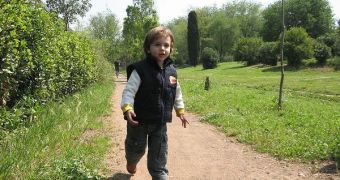It can take many months for a human newborn child to learn how to walk. In the first few months of life, the child is highly dependent on its parents for everything, and they learn to move on their own after much experimenting and failure. Experts have wondered for a long time why this is the case with our species, when other higher mammals give birth to cubs that are able to walk within hours of being born. The work uncovered that, in fact, all animals began to walk at the same stage in brain development. It would then appear that it takes a longer time for children to reach it, LiveScience reports.
Another factor that was determined to be of great importance in predicting the time when a creature would begin to walk was the size of that species' mature brain, as well as the type of stride it employed. For example, we walk by placing our heels on the ground, and placing all our body's weight on the bones. Other animals, such as cats and horses, step on the toes, or the equivalent of toes (hoofs), and do not place their heels on the ground, except in rare occasions.
According to the lead researcher on the new study, expert Martin Garwicz , from the Lund University in Sweden, it may be that, “The neuronal mechanisms that underlie the onset of walking are very similar in different mammals, and that they are activated at a very similar relative time point during brain development.” Details of the new investigation appear in the current issue of the respected journal Proceedings of the National Academy of Sciences (PNAS). How humans start walking is “something I've always wondered about/ Even children ask this question – how come a little foal can start walking straight after birth and it takes us such a long time?” he adds.
In the new work, he and his team looked at more than 24 mammal species (including chimps, hippos, camels and guinea pigs), and analyzed the correlations between a number of characteristic factors, such as the brain size and limb biomechanics. The group also set the reference time for the experiments to represent the moment of conception, and not that of the birth. The expert says that, when accounting for the development stage that the brain undergoes while the children are still inside the womb, different brain-mass patterns appear, and can be more easily explained.
“By increasing the time of development we grow a brain that is so much larger and so much more complex, and at first glance would seem so different from other species. But maybe the underlying principles and building blocks of development are similar in different species,” Garwicz says. “It is possible using our model and data from other mammals you can predict when a human baby will start walking despite the fact that we walk on two legs, despite the fact that we have a large brain, and despite the fact that we learn many other things,” he concludes.

 14 DAY TRIAL //
14 DAY TRIAL //